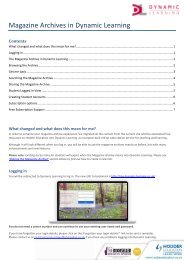POWER
OCR-A-Power-sample-chapter
OCR-A-Power-sample-chapter
Create successful ePaper yourself
Turn your PDF publications into a flip-book with our unique Google optimized e-Paper software.
1 Power in medieval Britain c1000–c1485<br />
1.2 The Norman Conquest and its impact<br />
KEY QUESTIONS<br />
The Norman invasion of 1066<br />
A Why were the Normans successful?<br />
The table below lists several factors behind the<br />
Normans’ success. Copy the table and look for evidence<br />
of each factor at work (in 1066 or in the decade after) as<br />
you read the topic. Record this evidence in column 2.<br />
At the end of the topic, use column 3 to rank the factors.<br />
Factor affecting Norman<br />
success<br />
luck<br />
a strong legal claim<br />
effective leadership<br />
loyal support<br />
the Church<br />
military power<br />
mistakes<br />
Anglo-Saxon wealth<br />
Anglo-Saxon administration<br />
brutal suppression<br />
other<br />
Evidence of<br />
this factor<br />
at work<br />
Importance<br />
(rank from<br />
most to least)<br />
The real point of the research stage is to prepare you for<br />
some serious thinking. Here is the kind of question you<br />
might be asked:<br />
The Norman Conquest was successful because the<br />
Normans were brutal. How far do you agree?<br />
FACTFILE<br />
The question is guiding you to one factor: brutality.<br />
However, you need to consider how important brutality<br />
was in the success of the Norman Conquest and<br />
whether other factors were more or less important.<br />
Your completed table and your judgement should mean<br />
you are ready to tackle this question.<br />
B How far did the Norman Conquest change<br />
England?<br />
The table below lists some features of Norman<br />
England. Copy the table and, as you work through the<br />
topic, look for evidence of change or continuity from<br />
Anglo-Saxon England. Add more rows if you need them.<br />
Feature of Anglo-Saxon<br />
England<br />
the Church<br />
land ownership<br />
government, law and<br />
administration<br />
life for ordinary people<br />
other<br />
A map showing the key events of 1066.<br />
Battle of Fulford<br />
Harald Hardrada and Tostig defeat<br />
Harold Godwinson’s supporters,<br />
Earls Edwin and Morcar,<br />
20 September<br />
Berkhamsted 7<br />
English leaders submit to<br />
William, end of October<br />
Wallingford 6<br />
Archbishop Stigand<br />
surrenders and ends<br />
attempts to put<br />
Edgar Atheling on<br />
throne, October<br />
Evidence of<br />
change<br />
Evidence of<br />
continuity<br />
As you read through the topic, think about the following<br />
question. You will answer it at the end.<br />
The Normans did not really bring any changes to England;<br />
they simply took over what was already there. How far do<br />
you agree with this view?<br />
8<br />
Brittany<br />
Coast<br />
ENGLAND<br />
Winchester<br />
Normandy<br />
Coast<br />
Canterbury<br />
1 Battle of Stamford Bridge<br />
Harold defeats Harald Hardrada<br />
and Tostig Godwinson,<br />
25 September<br />
2 London<br />
William crowned king,<br />
25 December<br />
3 Southwark<br />
William repulsed,<br />
mid-October<br />
4 Battle of Hastings<br />
William defeats Harold,<br />
who is killed, 14 October<br />
5 Pevensey<br />
William lands in England,<br />
28 September<br />
Uncorrected proof<br />
1 Study Sources 1–3. What<br />
does each source say about<br />
William’s or Harold’s claim<br />
to the throne?<br />
2 Explain the differences<br />
between the three sources<br />
and suggest reasons for<br />
these differences.<br />
Source 3 Norman writer William<br />
of Jumièges, writing c1070.<br />
Edward king of the English sent<br />
his Archbishop of Canterbury to<br />
appoint him heir to the kingdom.<br />
But he also, at a later date, sent to<br />
him Harold, the greatest of the earls<br />
in the land, to swear loyalty to the<br />
duke concerning the crown.<br />
January 1066: Harold Godwinson becomes king<br />
When Edward the Confessor died in January 1066, Harold Godwinson became<br />
king. According to the ANGLO-SAXON CHRONICLE it was a simple succession (see<br />
Source 1). Edward’s great-nephew, Edgar Atheling, had a better legal claim to the<br />
throne than Harold, but he was only 15 years old and few Anglo-Saxon nobles<br />
preferred him as king. The Witan wanted a strong leader who could defend and<br />
run the country, and Harold Godwinson was the richest and most powerful man<br />
in England. He was a proven war leader. In 1065 he had even exiled his own<br />
brother, Tostig, for ruling badly and upsetting the thegns. Harold had England<br />
united behind him.<br />
William of Normandy claims the throne<br />
Across the English Channel sat William, Duke of Normandy. England was<br />
extremely wealthy – the richest country in Europe – and William saw it as a<br />
tempting prize. He claimed that Edward the Confessor, who had strong links to<br />
Normandy and was distantly related to William, had promised him the English<br />
throne in 1051. He also claimed that Harold Godwinson had pledged loyalty to<br />
him in 1064. This was true, but Harold argued that this oath of loyalty was forced<br />
out of him while he was being held hostage by William after a shipwreck. To<br />
boost his claim still further, William won the support of the POPE, which allowed<br />
him to claim that God was on his side.<br />
Source 1 An extract from the Anglo-Saxon Chronicle, published soon after 1066.<br />
Harold Godwinson succeeded to the throne of England in 1066, just as King Edward had<br />
granted it to him and as he had been chosen for the position.<br />
Source 2 A scene from the Bayeux Tapestry, showing Harold promising loyalty to<br />
William of Normandy.<br />
20<br />
21




